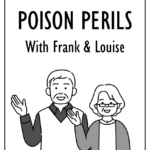What is mercury?
Mercury is a metal that can be harmful if you breathe it in or swallow it. Mercury is most dangerous for young children and women who are pregnant, breastfeeding or may become pregnant.
Metallic mercury is a thick, silver liquid. It is also called elemental mercury. Small amounts of metallic mercury are found in fluorescent light bulbs (including CFLs), old thermometers, thermostat switches and some computer screens.
Mercury poisoning is rare, but you can breathe in metallic mercury if you do not clean up broken fluorescent light bulbs or thermometers in the right way.
What are the symptoms of mercury poisoning?
If you breathe in large amounts of mercury, you may:
- Have headaches
- Feel moody or cranky
- Feel tiredness or weakness
- Have trouble sleeping
- Feel shaky
- Get a rash
If you are around large amounts of mercury while pregnant or breastfeeding, your child may have trouble:
- Seeing
- Hearing
- Remembering
- Learning
They may also be moody or shy, or have shakes.
Young children who are around a lot of mercury can also have these problems.
What can you do about mercury poisoning?
Call the poison center at 1-800-222-1222 if:
- Someone has swallowed something with mercury in it.
- Someone has breathed in a lot of mercury.
- You think your child has mercury poisoning.
If you have broken a fluorescent bulb or thermometer:
- Air out the room. Open windows in the room and close the door to the rest of the house. Leave the room for 15 minutes. If the bulb broke on a rug, put the rug outside to air out.
- Clean up. Do not use a vacuum cleaner to clean up mercury. The mercury will stick to your vacuum and get in the air every time you use it.
- For a fluorescent bulb:
- Put on disposable rubber gloves
- Collect the broken glass pieces and powder with masking tape and stiff paper or cardboard.
- Wipe the area with wet paper towels.
- For a thermometer:
- Put on disposable rubber gloves.
- Use stiff paper or cardboard to scoop up mercury droplets. Pushing them together can make it easier to pick them up. Use a flash light to spot them if they are in a dark area.
- Use masking tape to pick up anything that is left.
- If you spilled a lot of mercury or if the spill was in a hard-to-clean area, such as with cracks or carpet, call your state environmental department to find out if you need help cleaning up.
- Maine: (800) 452-4664
- New Hampshire: (603) 271-8876
- Vermont: (802) 241-3455
- For a fluorescent bulb:
- Throw away. Put all of the trash in a glass container or in two zipper bags. The trash includes the glass pieces, powder or droplets, gloves, masking tape, cardboard and paper towels. Put the glass container or plastic bags outside in a place where children and animals cannot get to it.
- Wash your hands.
- Get rid of it. Call your town office to find out when and where to get rid of your broken light bulb or thermometer.
- Vacuum later. The next time you vacuum the area where the mercury was, keep the windows open and throw away the vacuum bag afterwards.
If you are pregnant, breastfeeding or may become pregnant, do not clean up the mercury yourself.
Keep children and pets away while cleaning mercury.
Get rid of mercury in a safe way
Mercury can be harmful if it gets into the environment and then into the fish that we eat, so it is important to throw it away in a safe way.
- An easy way to get rid of things that contain mercury is at a household hazardous waste collection. Most towns hold at least one collection a year. Call your town office to find out when the next one will be.
- Some hardware stores will take old or broken CFLs.
Keep things that contain mercury in a sealed container, out of the reach of children, until you are ready to get rid of them.





